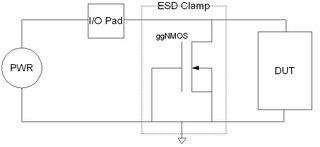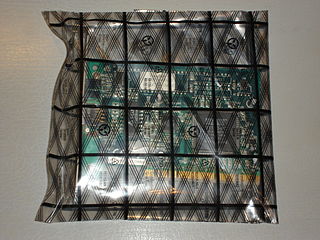Related Research Articles

Electromagnetic compatibility (EMC) is the ability of electrical equipment and systems to function acceptably in their electromagnetic environment, by limiting the unintentional generation, propagation and reception of electromagnetic energy which may cause unwanted effects such as electromagnetic interference (EMI) or even physical damage to operational equipment. The goal of EMC is the correct operation of different equipment in a common electromagnetic environment. It is also the name given to the associated branch of electrical engineering.
Conformance testing — an element of conformity assessment, and also known as compliance testing, or type testing — is testing or other activities that determine whether a process, product, or service complies with the requirements of a specification, technical standard, contract, or regulation. Testing is often either logical testing or physical testing. The test procedures may involve other criteria from mathematical testing or chemical testing. Beyond simple conformance, other requirements for efficiency, interoperability, or compliance may apply. Conformance testing may be undertaken by the producer of the product or service being assessed, by a user, or by an accredited independent organization, which can sometimes be the author of the standard being used. When testing is accompanied by certification, the products or services may then be advertised as being certified in compliance with the referred technical standard. Manufacturers and suppliers of products and services rely on such certification including listing on the certification body's website, to assure quality to the end user and that competing suppliers are on the same level.

Electrostatic discharge (ESD) is a sudden and momentary flow of electric current between two differently-charged objects when brought close together or when the dielectric between them breaks down, often creating a visible spark associated with the static electricity between the objects.
The JEDEC Solid State Technology Association is an independent semiconductor engineering trade organization and standardization body headquartered in Arlington County, Virginia, United States.

Static electricity is an imbalance of electric charges within or on the surface of a material. The charge remains until it can move away by an electric current or electrical discharge. The word "static" is used to differentiate it from current electricity, where an electric charge flows through an electrical conductor.

A steel-toe boot is a durable boot or shoe that has a protective reinforcement in the toe which protects the foot from falling objects or compression. Safety shoes are effective in keeping the feet of industrial workers safe from sharp and heavy objects while working in factories.

A surge protector (or spike suppressor, surge suppressor, surge diverter, surge protection device or transient voltage surge suppressor is an appliance or device intended to protect electrical devices in alternating current circuits from voltage spikes, which can arise from a variety of causes including lightning strikes in the vicinity and have a very short duration measured in microseconds.

High voltage electricity refers to electrical potential large enough to cause injury or damage. In certain industries, high voltage refers to voltage above a certain threshold. Equipment and conductors that carry high voltage warrant special safety requirements and procedures.

An electrostatic-sensitive device is any component which can be damaged by common static charges which build up on people, tools, and other non-conductors or semiconductors. ESD commonly also stands for electrostatic discharge.

Grounded-gate NMOS, commonly known as ggNMOS, is an electrostatic discharge (ESD) protection device used within CMOS integrated circuits (ICs). Such devices are used to protect the inputs and outputs of an IC, which can be accessed off-chip and are therefore subject to ESD when touched. An ESD event can deliver a large amount of energy to the chip, potentially destroying input/output circuitry; a ggNMOS device or other ESD protective devices provide a safe path for current to flow, instead of through more sensitive circuitry. ESD protection by means of such devices or other techniques is important to product reliability: 35% of all IC failures in the field are associated with ESD damage.

The human-body model (HBM) is the most commonly used model for characterizing the susceptibility of an electronic device to damage from electrostatic discharge (ESD). The model is a simulation of the discharge which might occur when a human touches an electronic device.
Electronic packaging is the design and production of enclosures for electronic devices ranging from individual semiconductor devices up to complete systems such as a mainframe computer. Packaging of an electronic system must consider protection from mechanical damage, cooling, radio frequency noise emission and electrostatic discharge. Product safety standards may dictate particular features of a consumer product, for example, external case temperature or grounding of exposed metal parts. Prototypes and industrial equipment made in small quantities may use standardized commercially available enclosures such as card cages or prefabricated boxes. Mass-market consumer devices may have highly specialized packaging to increase consumer appeal. Electronic packaging is a major discipline within the field of mechanical engineering.

An antistatic device is any device that reduces, dampens, or otherwise inhibits electrostatic discharge, or ESD, which is the buildup or discharge of static electricity. ESD can damage electrical components such as computer hard drives, and even ignite flammable liquids and gases.

An antistatic bag is a bag used for storing electronic components, which are prone to damage caused by electrostatic discharge (ESD).
Transmission-Line Pulse (TLP) is a way to study integrated circuit technologies and circuit behavior in the current and time domain of electrostatic-discharge (ESD) events. The concept was described shortly after WWII in pp. 175–189 of Pulse Generators, Vol. 5 of the MIT Radiation Lab Series. Also, D. Bradley, J. Higgins, M. Key, and S. Majumdar realized a TLP-based laser-triggered spark gap for kilovolt pulses of accurately variable timing in 1969. For investigation of ESD and electrical-overstress (EOS) effects a measurement system using a TLP generator has been introduced first by T. Maloney and N. Khurana in 1985. Since then, the technique has become indispensable for integrated circuit ESD protection development.
Reliability of a semiconductor device is the ability of the device to perform its intended function during the life of the device in the field.

An ESD simulator, also known as an ESD gun, is a handheld unit used to test the immunity of devices to electrostatic discharge (ESD). These simulators are used in special electromagnetic compatibility (EMC) laboratories. ESD pulses are fast, high-voltage pulses created when two objects with different electrical charges come into close proximity or contact. Recreating them in a test environment helps to verify that the device under test is immune to static electricity discharges.
The National Operating Committee on Standards for Athletic Equipment is a nonprofit standards organization which develops standards for the manufacture of certain protective athletic equipment in the sports of baseball, football, hockey, lacrosse, and polo. NOCSAE conducts and funds scientific research and collects and analyzes data relating to standards development.
An electromagnetic pulse (EMP), also referred to as a transient electromagnetic disturbance (TED), is a brief burst of electromagnetic energy. The origin of an EMP can be natural or artificial, and can occur as an electromagnetic field, as an electric field, as a magnetic field, or as a conducted electric current. The electromagnetic interference caused by an EMP can disrupt communications and damage electronic equipment. An EMP such as a lightning strike can physically damage objects such as buildings and aircraft. The management of EMP effects is a branch of electromagnetic compatibility (EMC) engineering.

Electrostatic discharge materials are plastics that reduce static electricity to protect against damage to electrostatic-sensitive devices (ESD) or to prevent the accidental ignition of flammable liquids or gases.
References
- ↑ "ESD Turnstile Access Control System: Frequently Asked Questions". Environmental XPRT. Retrieved 22 March 2024.
- ↑ "What is ESD-protected entry control system?". Medium.com. Retrieved 28 March 2024.
- 1 2 "A Beginner Guide to ESD Turnstiles". macrosafegates.com. Retrieved 22 March 2024.
- ↑ "ANSI/ESD S20.20-2021 - Protection of Electrical and Electronic Parts, Assemblies and Equipment (Excluding Electrically Initiated Explosive Devices)". webstore.ansi.org. Retrieved 22 March 2024.
- ↑ "Why ESD Testing Turnstiles Are Vital in the semiconductor industry". ChampStory. Retrieved 28 March 2024.